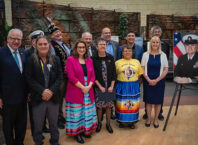NOT JUST STANDING ROCK: WATER SOURCES ALONG PIPELINE AT RISK
DES MOINES, Iowa (AP) – A Native American tribe’s fight over its water source has grown into an international cause, with all attention focused on the Dakota Access pipeline’s route in southern North Dakota. But contractors on the project, which passes through three other states, have been drilling under and through rivers that are equally critical water sources for hundreds of thousands of people.
One city managed to avoid the situation – Bismarck, North Dakota, the center of government in the oil-rich state and home to 67,000 people. Others, including Des Moines, Iowa, didn’t, despite protests that led to arrests.
At issue is whether a breach in the $3.8 billion project, being built by Dallas-based parent company Energy Transfer Partners, will affect drinking water, given that it crosses more than 200 water bodies, including the Des Moines and Raccoon rivers. While utility officials in Iowa acknowledge it’s likely there’ll be an issue in the future, they’re confident a leak won’t affect the quality of the water.
Energy Transfer Partners counters that the 1,170-mile pipeline will be safe, with devices placed through-out to track pressure, temperature, density and flow that’ll be monitored around the clock by people who can remotely shut off oil flow.
Pipe was laid early in December under the Des Moines River, and the route also crosses the Raccoon or its tributaries at three locations upstream from Des Moines, a city of more than 200,000 residents.
Des Moines Water Works CEO Bill Stowe said there is a plan to deal with an oil leak, and he works with the U.S. Department of Transportation to ensure regular inspections and appropriate flow-stopping measures.
The Dakota Access pipeline also crosses underneath the Mississippi River, which is a source of water for about 4,000 people in the southeast corner of Iowa. The utility’s officials voiced concerns to the Iowa Utilities Board, telling them that a preferred a route would be south of the city’s intake, but the route wasn’t changed. A leak could reach the intake within an hour.
Carolyn Raffensperger, executive director for the Iowa-based environmental group Science and Environmental Health Network, noted the frustration she felt while watching the drilling and pipe installation. She has filed legal challenges and criticized the regulatory process for pipeline permitting, saying the layers of bureaucracy makes it difficult for citizens to be heard in any significant way.
“The problem is a very little bit of oil can make a very big mess,” she said. “We don’t want to drink any oil.”
FOND DU LAC BAND DEDICATES NEW $14 MILLION CENTER IN DULUTH
DULUTH, MN – The Fond du Lac Band of Lake Superior Chippewa celebrated the dedication of a bigger and better Center for American Indian Resources in Duluth in December.
In a city with multiple choices for receiving health care from well-trained medical staff, Phil Norrgard thanked the patients who have chosen to use the Center for American Indian Resources since it opened in Duluth in 1988.
“Even though they had to sit and wait in a postage stamp of a waiting room … you came. You came week after week, month after month, year after year,” said Norrgard, who is the director of human services for the Fond du Lac Band.
People seeking care at the center on the 200 block of West Fourth Street will now find a new building with an additional 30,000 square feet and dozens more staff. The $14 million building was dedicated before a packed room on the first level of the new building.
New services will include “culturally responsive” on-site behavioral health and chemical dependency treatment, as well an expansion of the center’s pharmacy and counseling and case management services.
Norrgard thanked the Fond du Lac Band’s government, saying, “Our leaders deserve some thanks and gratitude on a day like today when we can look around and all be happy and grateful for the beauty and the opportunity that’s been brought into our life and brought into our community by people willing to take a stand and devote resources to the places where resources need to be devoted.”
DEFENDERS OF BLACK HILLS DISBAND AFTER 14 YEARS
RAPID CITY, S.D. (AP) – Following 14 years of efforts to preserve Native American sacred sites from desecration and to protect natural resources from fracking, uranium mining and over-harvesting of timber, the nonprofit Defenders of the Black Hills has decided to call it quits.
The organization’s final meeting was conducted in late December at the Mother Butler Center in Rapid City, and with smiles, hugs and a few tears. At the farewell, supporters celebrated nearly a decade and a half of volunteer activism and partnerships developed, all in the name of protecting the environment.
The decision to disband was not made without careful thought, said Charmaine White Face, one of the group founders and its coordinator since its inception.
“I’m getting old and tired,” said White Face, who turns 70 in March. “There are other groups now but, when we started, there were hardly any. Others will take up the mantle, but we feel like it’s time now. It’s time to back out.”
Defenders of the Black Hills was founded in 2003 to counter federal legislation passed that opened up the last 3 percent of the Black Hills to logging, including a wilderness area and two roadless areas that were supposed to be preserved untouched for time immemorial.
In the ensuing years, the Defenders group has pestered those promoting mineral extraction and fracking, successfully promoted legislation funding the cleanup of abandoned uranium mines and worked to prevent water pollution in the region.
In January 2003, White Face said the Defenders had 32 issues on its docket, all intended to protect, preserve and restore the environment. Among those issues was a firing range proposed within sight of Bear Butte, a sacred site to several Native American tribes. So the newly formed group held a prayer gathering at Bear Butte, followed by a dinner at Sturgis Brown High School attended by 200, she said.
At that session, a local attorney stepped forward and offered his services pro bono to the Defenders. Further investigation of the planned firing range found it was going to be financed through a Community Development Block Grant, a federal funding mechanism designed to assist poor people, White Face explained.
Over the years, efforts by White Face and the Defenders have been recognized far and wide.
In 2007, the organization won the Nuclear Free Future Award, described as “the Nobel Prize for Environmentalists.” Last summer, White Face was named a Giraffe Hero by the Giraffe Heroes Project, a nonprofit organization that encourages people to “stick their necks out for the common good.”







